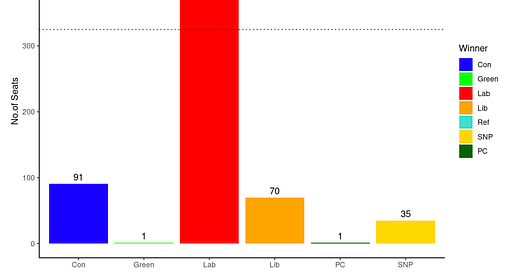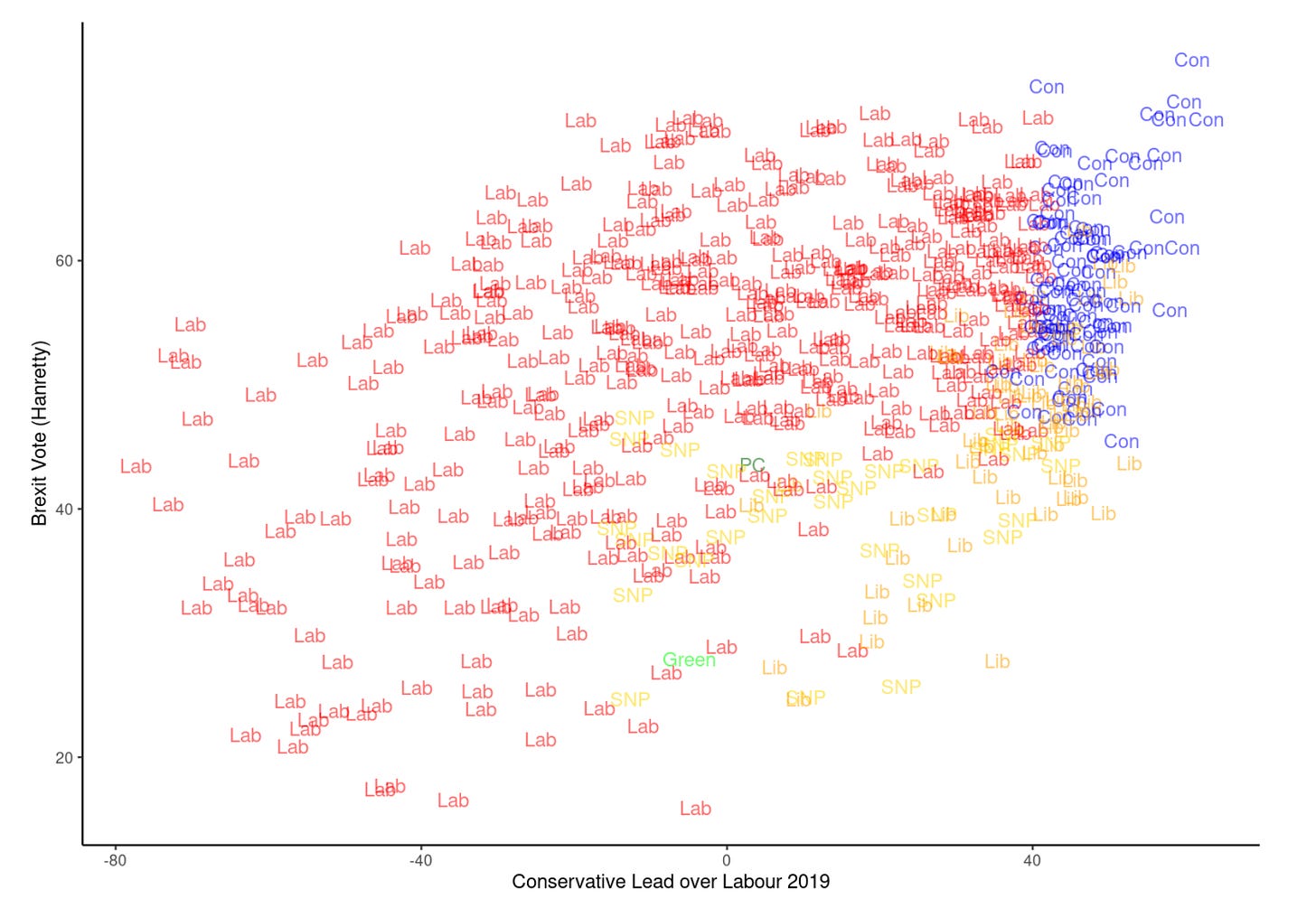Probably the best advice for political scientists was that of the don of psephology at Oxford, David Butler: don’t give point predictions. That is good advice. Smarter colleagues than me - Jane Green, Geoff Evans - they refrain from trying to predict elections - they analyse them. But I’m just a guy standing in front of my subscribers with an election prediction app, asking you to use it.
So I will. What’s going to happen in the General Election tomorrow? Polls, actually scratch that, MRPs, show a very wide range of possibilities. None of which are good for the Conservatives and most of which are very very good for Labour. Sometimes, the Liberal Democrats come close to being the second largest party in Parliament. Sometimes Reform get 1 seat, sometimes they get 10. Sometimes the SNP is decimated, other times it does OKish. Sometimes the Greens win one seat, sometimes two. How do we know which is right?
Well we won’t until Friday. And even then the underlying model for the lucky prediction may have got there by chance not because it truly picked out the myriad of ways in which demographics, regional factors, and polling uncertainty combine into 650 different seat outcomes. Well actually 631 because very few people are bothering to calculate the 18 Northern Irish seats and we all know the Speaker will win his seat.
I have written a series of articles about my own election app over the past few years. It allows you to do a bunch of things. Use different types of swing - Uniform vs Proportional; use different assumptions about tactical voting; put in whatever polling numbers you want. So it can produce all kinds of fun stuff. It has its weaknesses - it’s based on how parties did last time and since the Brexit Party stood down in Conservative seats in 2019 but Reform UK will not do the same this time, there is at least some problem there. And I don’t have all kinds of wiz-bang regional differences you can get from an MRP.
But one thing I like about my app is that it’s transparent. The code for it is here. You could, should you wish, edit it yourselves. And it means I know what I need to do if I am going to make a prediction: enter the current polling averages, make an assumption about swing, and make an assumption about tactical voting. So let’s do that.
Let’s start with polling. We have had a wide array of national estimates using different techniques - some by phone, some online; some making model-based adjustments to don’t knows, others remaining agnostic. My plan is simply to take the average of all of them and, I don’t know, hope that the law of large numbers kicks in. Actually, I am going to be even lazier and the use the FT polling average (and for the SNP the estimate of 2.9% and Plaid 0.5%).
So this gives us:
Labour: 40.4
Conservative: 20.6
Reform UK: 16.1
Liberal Democrats: 11.4
Greens: 6
SNP: 2.9%
Plaid Cymru: 0.5%
Next assumption is what type of swing there is going to be. I think the very large decline in Conservative support suggests that a proportional swing model is going to more accurate. Peter Kellner has some nice writing about this here. Basically, when you have landslide collapse elections - Lib Dems in 2015, Labour in Scotland in 2015, Conservatives in 1997 - then proportional swing works better than uniform national swing. What this means is that if the Conservatives drop from 45 to 22.5% of the vote in aggregate between 2019 and 2024, we halve their expected vote share in each constituency from what it was in 2019 - so 70% becomes 35% etc. (UNS would be subtracting 22.5% from the 2019 scores, which will be more than half in some cases and less than half in others).
Finally, we have tactical voting. In a previous piece I argued for an assumption that 30% of anti-Conservative voters would vote for the party among Labour, the Lib Dems, and the Greens that came second last time. Is this accurate? Who knows? Will Green voters behave like Labour and Lib Dem ones? I suspect not. But 30% has the merit of having some data behind it.
What about Reform voters? Will any return home to the Conservatives? I suspect a few will. Here I am going to pull out a figure of 20%. From where? Well, the recent decline in Reform support has been of about that magnitude and I think that’s likely to be returning voters. But again, who really knows? These are all assumptions and they may or may not be right.
There is one final trickiness which is whether polls reflect the level of tactical voting or not. That is, if Labour get 40% in the polls is this before or after tactical voting? And does it include all the Lib Dems and Greens going Labour as well as the Labour voters going Lib Dem or Green? Very very hard to know. But I think it’s probably safer not to adjust the poll numbers themselves and if you think they already include some tactical voting then feel free to adjust the sliders in the app to less than 30%.
So… drumroll… what do we get?
A huge Labour majority and the Conservatives under 100 seats.
Good news for the Conservatives, they are still the second largest party. Bad news is that I am likely underestimating Reform since they don’t win a seat in my model because it only adjusts relative to 2019. I expect them to win Clacton and either retain Ashfield or win another (maybe Great Yarmouth). There is some informal evidence that Reform could end up with closer to ten seats. I think that’s quite possible given that at least some of their vote is quite geographically concentrated (in the old Danelaw). That will almost certainly come at the expense of the Conservatives who could lose enough seats to be closing in on the Lib Dems - from the wrong direction.
I am also skeptical about the results for Scotland. My analysis has the SNP retaining more than half of the seats in Scotland - I suspect they will end up with only around half (so just under 30). The beneficiaries will mostly be Labour. Part of the issue is I am keeping UNS for Scotland (don’t ask… too hard to adjust the model for that).
So making back of the envelope adjustments I see the Conservatives more in the low to mid 80s (let’s call it 85), Reform with let’s say 6, the SNP with 28 and Labour with 440. Lib Dems still on 70. That’s my adjusted prediction.
Let’s look at the geographical distribution of seats. Here’s a hex map.
Unsurprisingly, it’s very red. The Conservatives are limited largely to the Danelaw (where they haven’t lost seats to Reform), bits of the South coast and a smattering of the Midlands. The Lib Dems are the rulers of Wessex. And Southwest London.
Here’s how this plays out against Chris Hanretty’s Brexit vote estimates for each (new) constituency. The Conservatives are reduced to a series of very Brexity seats. The Liberal Democrats are mostly confined to Remainia but with some breakthrough in Southwest seats that narrowly voted for Leave.
You might ask, what if swing is not proportional? What if UNS wins again? Well it’s quite a bit better for the Conservatives. And still not anywhere near a majority. But it looks much more like 1997. So just the thirteen years out of office.
And what if we had PR instead? Well then Labour would need to go into coalition with the Liberals, and maybe also the Greens. A very different world for parties of the right, most obviously Reform who would have over one hundred seats (the comparison here btw is with UNS). As we now know, some conservative commentators have magically discovered the wonders of proportional electoral systems is a Damascian conversion that is not at all in bad faith. Well, lads, you fight elections in the system you’re in not the system you wish to have.
So, that’s my guess. Labour with 440, the Conservatives with 85, Liberal Democrats with 70, SNP with 28, Reform with 6, the Greens with 1, and Plaid with 1. Adds up to 631 so that’s good.
If you’re interested in which seats I predict in what way you can download the spreadsheet here.
And having put my neck on the line, I’ll be interested to see how wrong I was and in what way. I believe in being consistent to my method so my prediction is my prediction. But… if I am wrong I suspect it will be with the Conservatives doing better than the polls expect - with something looking much more like the UNS estimate. I think some don’t knows will come home (and I have already given 20% of Reform voters to them).
But look, Keir Starmer is going to be Prime Minister and Rishi Sunak will have led the Conservatives to their worst result in modern memory, possibly ever. If that doesn’t happen… well we will have a review of polling companies that will make the punishment beating of 2015 look like a sunny day trip out to a theme park, aka an Ed Davey photo-op. And political scientists like me will become personae non gratae for a while. So at least there’s an upside.









I appreciate the transparency.
Interesting work Ben, but ultimately of not much consequence! I anyway worry about publication of polling results during campaigns with their potential influences on public opinion and voting behaviour. But I accept this is debatable. Much better if you spent your time trying to fix the wrongs of our “rotten broken system” of democratic politics.